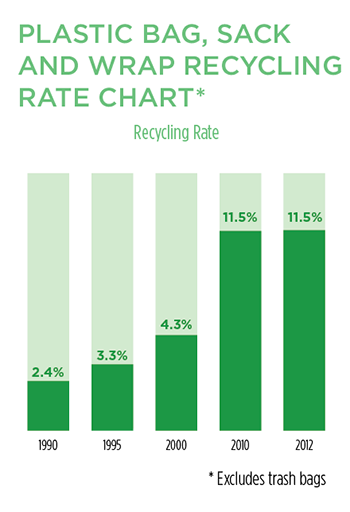Profiles in Garbage: Plastic Film 13490
Plastic film is a thin-gauge packaging medium used as a bag or a wrap. Examples include grocery sacks, trash bags, drycleaner bags and plastic wrap. Plastic film is less than ten mils in thickness, with an average of 0.7–1.5 mils. A mil equals 0.001 in. Most plastic trash bags are less than 1.0 mil in thickness. Individual bags are light in weight. For instance, 70 t-shirt bags weigh 1 lb. A 500-sq.-ft. plastic lumber deck with 2x6-ft. of lumber uses 140,000 bags.
Plastic film provides 5 percent of all packaging, 29 percent of plastic packaging and 12.2 percent of all plastic in the waste stream. Flexible packaging includes plastic film, paper bags, aluminum foil and cellophane. More than half of flexible packaging is plastic. Paper packages are most of the rest, with aluminum foil supplying a small percentage.
 Different resins and colors make plastic film difficult to recycle. More than 60 percent of plastic film uses low-density polyethylene (LDPE) or linear LDPE resin and approximately half of plastic film is pigmented.
Different resins and colors make plastic film difficult to recycle. More than 60 percent of plastic film uses low-density polyethylene (LDPE) or linear LDPE resin and approximately half of plastic film is pigmented.
Many films also blend or coextrude two or more resins. Also, individual product characteristics may create remanufacturing problems. For instance, stretch wrap requires a “tackifier” to make the wrap cling, yet this product quality is not desired in a bag.
Generated
4.83 million tons of plastic film, or 1.93 percent of MSW by weight.*
1.02 million tons of trash bags, 0.4 percent by weight.*
3.81 million tons of bags, sacks and wrap, 1.89 percent by weight.*
30.77 lbs. of plastic film per person.*
Recycled
440,000 tons, for a 9.1 percent plastic film recycling rate (includes trash bags which are not recycled).*
440,000 tons, for a 11.5 percent plastic bag, sack and wrap recycling rate.*
510,266 tons of post consumer film (including plastic bags) in 2012 according to industry data.
“Clean clear polyethylene film including stretch wrap and poly bags” are the most commonly recycled film plastic, supplying 46 percent of recycled film.
“Mixed film,” which includes bags dropped off at retail stores, is the second most commonly recycled source with 18 percent of recycled film.
(* = 2012 U.S. EPA estimates)
Recycled Content
Little, if any, post-consumer recycled content.
Pre-consumer recycled content is not unusual.
Recycled content can increase a bag’s thickness by 50 percent.
Composted
Plastic film does not compost.
Disposed via Landfilling or Energy from Waste
4.39 million tons, or 2.7 percent of discarded MSW by weight.*
Highly-combustible resin averages more than three times higher BTU than MSW.
Landfill Volume
13 million cu. yds. of plastic film, or 3.1 percent of landfilled MSW.
2.4 million cu. yds. of trash bags.
4.4 million cu. yds. of bags and sacks.
6.2 million cu. yds. of wrap.
 Density
Density

Landfilled plastic film that weighs 670 lbs. in a horizontal baler, will weigh approximately 1,100 lbs.
Source Reduction
Plastic grocery bags are now .5 mil thick, down from 2 mils when they were first made.
A laundry detergent flexible pouch weighs 85 percent less than a rigid plastic bottle.
Recycling Markets
59 percent was exported, primarily to China.
In the United States, 38 percent was made into plastic lumber, 21 percent was made back into film and sheet products and 41 percent went to other uses such as piping, automotive products, lawn and garden products, crates, buckets and pallets.
Strict Raw Material Specifications
Sort by resin, color and printed versus non-printed bags for highest value.
Labels, dirt, and food are the main contaminants.
Others include paper receipts, staples and other non-plastics.
Model bale specs can be found here.
Sources
2012 National Postconsumer Plastic Bag & Film Recycling Report, Moore Recycling
Municipal Solid Waste Generation, Recycling and Disposal in the United States: Facts and Figures for 2012, USEPA, February 2014
Measurement Standards and Reporting Guidelines, National Recycling Coalition
About the Author(s)
You May Also Like




